
Mr X met a formidable visual FX challenge in ‘The Three Musketeers’, building assets with millions of polygons, full CG shots in stereo 3D and perfecting light and textures on water and digital doubles. Digital FX Supervisor Eric Robinson and Lighting Supervisor Trey Harrell explain the details.
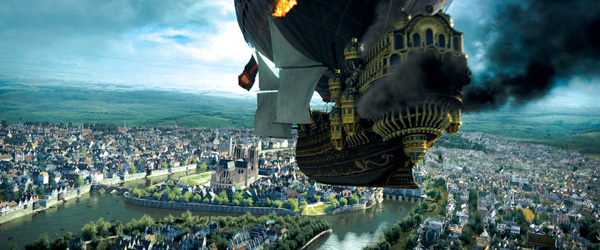 |
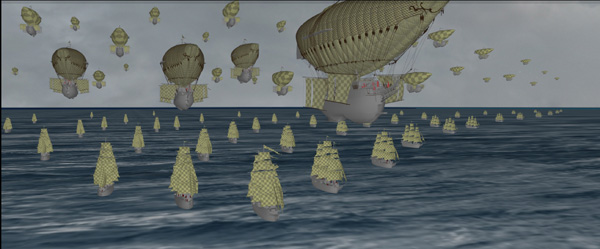 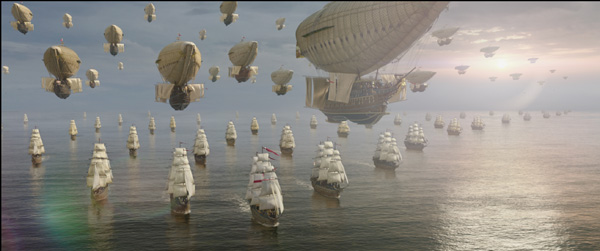 |
| Digital Effects Supervisor Eric Robinson estimates that the complexity of many of Mr X’s full CG shots in ‘The Three Musketeers’ was greater than on any project their team has tackled before. Such shots involved recreating 17th century Paris, a hero version of Notre Dame for enormous battling airships to land on or crash into, and digital doubles performing on rooftops. Mr X’s full staff across all teams numbered over 100, and the shot count reached 274.
Previs and Post-vis City Views The magnificent airships, which according to the story were based on Leonardo da Vinci’s own blueprints, were among the team’s top CG challenges. As they sailed overhead, they were almost always viewed from below. The larger ship’s crow’s nest area is only viewed from above once. The team’s first task was to sell the height and scale of the ships, 300 to 400 feet above ground at any time. “This became especially challenging in the climactic battle sequence when the ships are temporarily lost in cloud during a storm and the ground is not visible as a visual reference. As the sequence progressed and the cloud cover opened to show more land, we could prepare viewers for shots later on over Paris where the airships are much closer to the ground.” Airship Design |
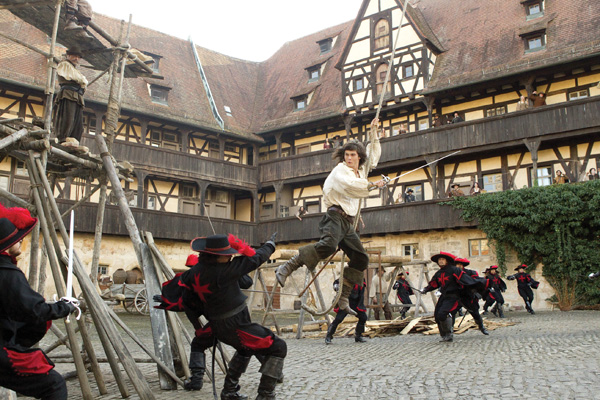 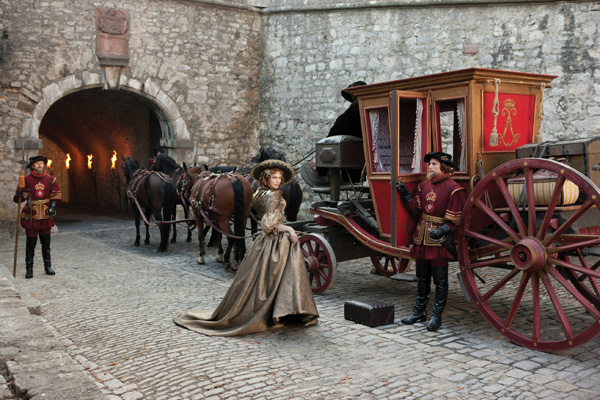 |
|
Scaling in Stereo Showing ripples of wind affecting the fabric of the sails and the ships balloons further helped convey scale. A cloth team built tools into the balloons so the animators could adjust how much effect the wind would have on the sails and balloons whether they were in stormy or calm skies, or landing and stopping. The environment, weather and lighting was always important aspects of storytelling in this film, for a few reasons. The clouds afforded attractive compositions and expressed dramatic cues for different levels of tension or humour in a scene. The Musketeers use the cloud as a place to hide during the stormy battle. The matte painting department developed several concept paintings for the storm and from these, the digital FX team projected layers of clouds onto geometry. Dramatic Skies Scene by scene, the skies would change from dark and overcast, to blown-out to beaming with sunlight. The airships’ journey to Paris needs to reach a climax as they pass through the storm and the team enhanced the drama through the lighting effects in the sky. When D’Artagnan triumphs at the end, the sky glows at the dawn of a new day with god rays shining down from the sun. At the heart of the storm these clouds and mist would move in around the airships, using a more complex simulation to allow foreground mist to curve around the CG objects. Meanwhile the team had to ensure everything was correctly layered to work in stereo. When the airships flew into a cloud bank, all elements had to be lined up perfectly to hold the correct illusion of disappearing into the clouds. Photo Survey For example, if a CG cannon shot a ball into an airship, the wood needed to splinter and fly off following realistic physical behaviour from all shooting angles. These simulations were computationally expensive and often tied up the render farm as they worked out the best process. Rank and File “Fifty live action soldiers were included at the shoot but 24,000 more were added digitally using Mr X’s own crowd system and animation cycles, resulting in ranks of living, breathing soldiers. Each was made to subtly shift weight or slightly sway, while the ranks were interspersed with isolated actions to add further signs of life. The Palace building standing in as the Louvre was a photographic element, but the grounds around it were CG, replacing the location’s current surroundings of a modern city. The element was isolated and a forest was added behind with the Seine River along one side to form the aerial view. The gravel forecourt where the soldiers stand is now a car park that the team made about five times larger. The environment was created from textured assets and projected or conventional matte paintings, always varied according to the proximity of the camera and the need to address parallax. Duelling Doubles “Another fight at the Tower of London features an explosion bursting through the Tower wall to the exterior. A flaming Beefeater falling from a burning window is actually a photo element while the hero D'Artagnan, leaping to safety onto the airship above them is replaced digitally. The Tower itself is also CG, and the small portion of the airship was in the plate and extended. “When we researched the Tower for this shot, we did the usual book research and photo survey on foot, but also surveyed from a helicopter to give us reference at the same aerial camera angles the director wanted in the CG shots. An action movie needs shots with dynamism,” Eric said. Global Illumination Pipeline “Traditionally in VFX, particularly with Renderman style pipelines such as those based on PRMan, Mantra or 3Dlight, artists would light with spotlights and try to mimic light bouncing around the room, or sunlight or fill light from the sky bouncing up off the ground. But now with physically based lighting tools artists could add for example, a Kino Flo 4 Bank to one side of a scene and have it render as if that lamp had been on set. They can achieve multiple light bounces intuitively without resorting to traditional ‘cheats’.” |
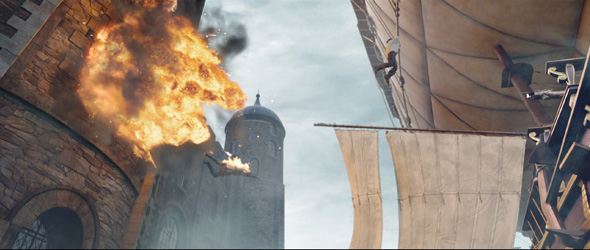 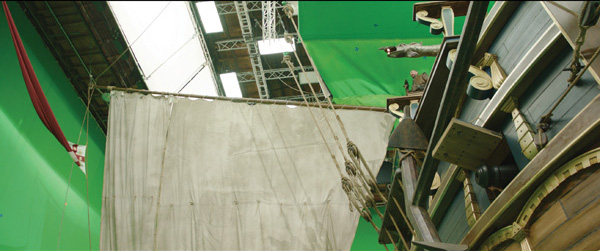 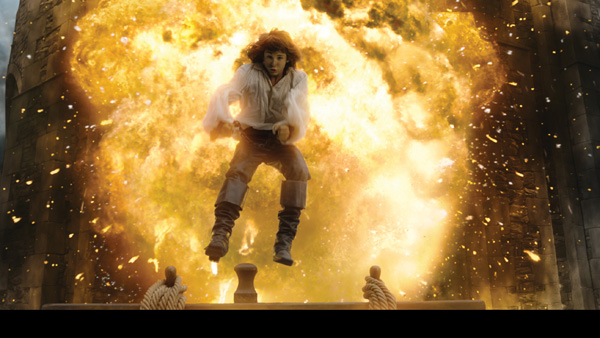 |
|
Aerial Views During the aerial battles, some of the full CG shots showed cannons firing into the airships, fire erupting on impact, smoke flying past the sails and dissipating. Each hit ended up being custom-made. They had intended to build up a library of cannon fire effects but the individual camera angles in one shot meant creating hero simulations for each one. Compositing was done in Nuke, in which the stereo tools were especially useful for subtly changing the stereo position of objects in a scene to improve the balance and focus attention. For example, when the airship crew begins throwing gear overboard to lighten it and the objects fall into camera on the ground, the director wanted to give the shot more impact. They were able to use Nuke tools to give more offset to objects to make them fall further into the audience. These tools also helped correct anomalies in the plate photography such as locational offset and keystoning. Magical Realism Given the level of influence the environment had in this story, Trey’s role as Lighting Supervisor was influential. He regarded the fine line the film took between fantasy and reality as a challenge to achieve ‘magical realism’. It’s not serious but rarely strays into comedy. To get started on lighting design , the team looked at reference from the ‘Pirates of the Caribbean’ films and ‘Stardust’ to ‘Master and Commander’ and some of Paul’s previous films. The light was also vital for the VFX as they involved so many CG assets. Lighting for realism is one thing but they also needed to communicate scale and mood and to give the audience clues for tension, optimism and humour. The best approach was to start each lighting scenario with the onset light data as usual and they proceed based on emotional cues. Few sequences ended up sticking strictly to HDR references. The amount of texturing and detail on the doubles, airships and Paris itself demanded an upgrade to their entire surfacing and texturing pipeline. Mr X was one of the first effects houses to purchase licences of Mari from The Foundry, which was adopted at the very beginning of the project. Without it, Trey doesn’t think they could have completed all the work, with as few staff as they had, in time. Balloon Textures Many approaches were applied to lighting a given scene, to set up interactive lighting for cannon blasts, for example, the ships might be rendered in V-Ray, explosions and smoke in Houdini while the debris was simulated in Houdini but rendered in V-Ray so the y would cast accurate shadows and bounce lighting back into the shot and mesh with everything else. At other times, the traditional methods worked, like throwing in an orange spotlight to light up an explosion in the side of a ship. Hybrid Escape |
| As D’Artagnan flees the bombs thrown into the Tower of London to escape on the stolen airship, the team took on a very hybrid approach to the whole shot, as Eric also described above. Trey said, “Practical photography included the Beefeater on fire, filmed elements of explosions projected back onto explosion cloud geometry, both matte painted and full CG elements of the Tower plus a postage stamp of the interior set inside the Tower, deliberately exposed for visibility. In addition a digital double of D’Artagnan leaps across to the almost entirely CG airship.”
In one layer, interactive light from the explosion affecting the double and the side of the ship was handled both as a V-Ray render pass and another Houdini render pass for fill light, then the re-lighting pipeline was used, where the compositors can place lights and flashes into a scene for detail, plus extensive moving roto mask work. Twice the Time “On ‘The Three Musketeers’, asset artists and animators were onto the shots from previs to help design them and once they were approved and shot, the rotoscoping department started immediately on clean up for hair and mattes, pulls keys, and makes decisions on where to seam up live action with CG material.” Then models are surfaced and textured and built while the asset and lighting teams work out look development to balance the final shot, and may have to pitch some looks to the VFX supervisor and director. Getting to the stage when effects animation is approved might take three months, after which tasks tend to split between the effects and lighting teams. After several more weeks of work, shots are presented in dailies and revised until they are right. “Planning definitely pays off even on shots that seem easy because you always end up having to think on your feet on the ones you least expect,” Trey said.
|


















